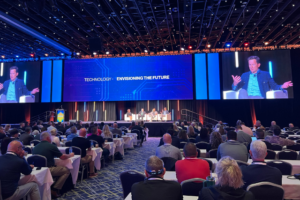Balancing Innovation with Expertise: Technology’s Role in the Future of Restoration


In today’s rapidly evolving property restoration landscape, technology is everywhere — from drones mapping rooftops to AI-powered tools helping generate repair estimates in seconds. But for contractors on the ground, innovation isn’t just about adopting new tools. It’s about finding the right balance between efficiency and expertise, and between connection, and complexity.

At this year’s Contractor Connection RESTORE Conference and Expo in Louisville, Kentucky, Paul Disney, itel’s Chief Product and Technology Officer, explained how cutting-edge tech should go hand-in-hand with a people-centered approach.
At itel, we know firsthand that technology can be a game-changer. But we also understand that it brings its own set of challenges, especially when it comes to implementation across diverse workflows and roles in the property claims process. As Disney put it during his panel discussion:
“Technology is making things more connected, but I think that’s happening more slowly than we would like. More and more we are realizing that having these multiple workflows can slow down the process. Anywhere we can take these incredibly powerful tools and have these tools talk to each other and save time is certainly a net positive.”
Contractors today face a common dilemma: how to integrate emerging technologies without losing sight of what matters most—people, processes, and outcomes. Whether you’re a restoration firm or an insurance carrier, there’s often pressure to invest in the latest tools. But technology that’s disconnected from day-to-day needs or from key players in the insurance ecosystem can create as many problems as it solves.
The key is intentional design, said Disney:
“As a product leader over the years, I’ve seen that sometimes you can sprint to building a solution instead of understanding what the ultimate outcome would be. It’s important to think through whether this is helping the customer or the user in the way that I would anticipate. Even if it does, what other challenges am I creating in other spaces?”
This perspective highlights a crucial point: the best technologies are built not just with innovation in mind, but with insight—real input from users across the ecosystem. That includes contractors, adjusters, and other third-party service providers who bring valuable experience and practical knowledge to every decision.
“It is important to leverage the deep expertise that exists in this room—with other contractors, adjusters, and training programs. Figuring out how to leverage more of that individual expertise rather than making those experts spend time on menial tasks makes the process better for everyone.”
At the core of these conversations is a shared recognition that people must remain central to the process. Technology should support expertise. It should accelerate the path to better decisions.
Ultimately, restoration professionals don’t need technology for technology’s sake. They need tools that connect to each other, reduce friction, and amplify human insight. They need solutions that help teams spend less time on manual tasks and more time doing what they do best: solving problems, serving customers, and restoring homes.
There’s no question that the next five to ten years will bring dramatic shifts to this industry. As AI and automation become more sophisticated, the most successful teams will be those who stay educated, stay connected, and stay focused on the outcomes that matter.
By taking the time to understand both the risks and the rewards of emerging technologies, contractors and carriers alike can position themselves to lead—rather than react—in the next era of restoration. Because as exciting as innovation can be, the real win lies in delivering faster, smarter, and more accurate results — with people always at the center.